Visit our sister site pollmans.com
Tanzania offers a unique wildlife experience across famous game parks with a stunning backdrop of one of Africa’s most magnificent sights, Mount Kilimanjaro. To the north lies the breath-taking Ngorongoro Crater, a UNESCO Conservation Area and site of the world’s largest intact volcanic caldera. Teeming with wildlife, clients have the opportunity to get incredibly close to the natural ecosystem.
Tanzania’s biggest annual event begins in Serengeti National Park where the annual migration of more than a million wildebeest surging across the plains is one of the most dramatic displays of nature one can witness today.
The territorial conquest in search of sustenance drives the animals to migrate across the plains of Serengeti, braving crocodile infested waters and Africa’s ferocious predators in a bid for survival.
The Southern circuit in Tanzania consists of the Selous Game Reserve and Ruaha National park. The lifeline of Selous is Rufuji River supporting a population of bird life and wildlife including elephant, buffalo, hippo, crocodiles as well as magnificent scenery. Ruaha is a true wildlife haven, sustained by the Great Ruaha River and central for the resident crocodile, hippo, turtle and fish there as well as a huge array of over 400 bird species.
Ranger Safaris is one of the most established and experienced operators
in Tanzania. Our driver-guides are among the most dedicated and
knowledgeable in terms of fauna and flora and continue to entice guests with their keen ability to locate wildlife and provide in depth knowledge. Our fleet of four-wheel-drive vehicles is one of the newest and largest in Tanzania and ideal for traversing Tanzania’s rugged terrain.
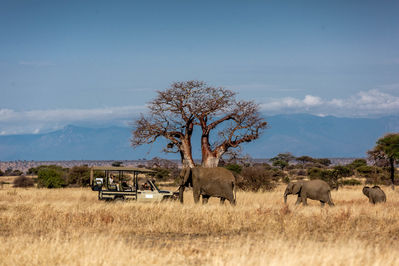
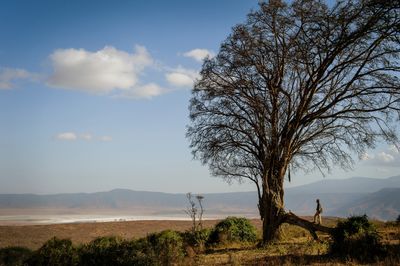
The Serengeti is one of the largest wildlife sanctuaries in the world. The most famous features of the Serengeti ecosystem are the spectacular concentration of plains animals, found nowhere else in the world, and the annual wildebeest migration. The park itself covers an area of 15,000 square kilometres and adjoins other reserves, such as the Ngorongoro Conservation Area to the south and the Masai Mara (in Kenya) to the north, making a huge total area in which the wildlife can continue its age old cycles of life and death, protected and undisturbed.
The terrain of the park varies from the short and long grass, open plains in the south, the acacia savannah in the central area, the hilly, more densely wooded northern section, and the extensive woodland and black clay plains, dominated by the central ranges of mountains in the western corridor. The plains are dotted with rocky outcrops known as "kopjes", and there are several rivers running through the park, notably the Seronera River in the central area, the Grumeti River in the Western corridor and the Mara River in the north.
Apart from the wildebeest and zebra, you can expect to see a large variety of animals. Gazelle varieties include the tiny Dik Dik, Thompsons gazelle, Grants gazelle, topi, waterbuck, greater and lesser kudu and many others. Hippos will be found in their pools at any time of year. Elephant will frequently be seen but the population here is migratory, and the numbers in different areas will vary from season to season.
There are huge herds of buffalo and a large population of giraffe. The rhino, once close to extinction, is making a comeback in Serengeti National Park, however chances are not always good that they will be sited here. Apart from the bigger game, there are some enchanting little creatures around such as mongoose, bat eared foxes and rock hyrax.
There are not many monkeys and apes in the Serengeti, but you will see baboons and black faced Vervet monkeys, particularly near the lodges.
The Serengeti predators, made famous by many films and documentaries, include lion, leopard, cheetah and hyena.
The birds of the Serengeti are just as spectacular and varied as the mammals. There are several types of eagles and vultures, ostrich, secretary birds, Kori bustards, hornbills, guinea fowl as well as a host of smaller birds. There have been almost 500 species of birds recorded in the park, including several that migrate from Europe and Asia in the winter months.
Visitors must not expect to see every animal and bird on every visit. The area is vast, and the migratory and weather patterns mean that many of the animals are constantly on the move. What you will see on any given trip depends on the season, the weather, on the skill of your driver/ guide and most of all, on luck.
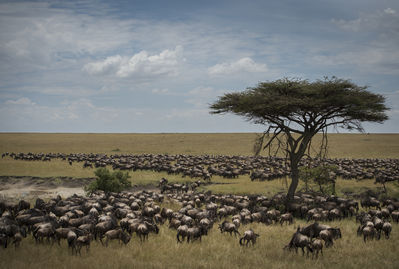
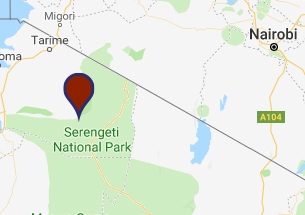
This remarkable and world famous geographic feature is considered a "caldera" - a collapsed volcano. The floor is an area of over 102 square miles includes a large soda lake and forms a perfectly preserved and self contained habitat for a huge number and variety of animal species. In fact, more than 30,000 animals call the Ngorongoro Crater their home.
Elephant, Buffalo, Hippo and many other species can generally be seen here at any time of year. Maasai tribesmen have traditional grazing rights here and they may be seen in their distinctive dress, tending their herds of cattle. The animals are not trapped in the crater, and there is some migratory movement in and out, but because of the protected nature of the habitat and the availability of grazing and water, much of the animal population remains resident year round. This makes Ngorongoro ideal for game viewing. There are several prides of lion, and some of the last surviving rhino to be found in Tanzania.
The alkaline soda lake can be home to huge flocks of flamingos, a remarkable and unforgettable sight when in residence. The whole crater has a quite unique almost magical atmosphere.
There are lodges and camps situated around the crater rim, and the descent into the crater and tour are taken in 4 wheel drive vehicles since the entry and exit roads are steep and unsuitable for minibus. Full day tours include a picnic lunch in a scenic spot right in the crater itself.

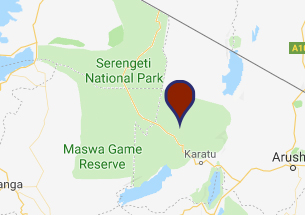
This charming park is tiny by comparison with most of the others on a safari itinerary but its special qualities and abundant wildlife make it a most worthwhile visit. The park covers only 330 square kilometres of which 230 are the lake itself.
The park lies under the wall of the great rift valley escarpment. The lake is quite shallow and can almost disappear in the dry season but there are permanent water sources which have produced a lush forest and a variety of imposing and interesting trees. This is not technically a rain forest but is very similar, dense and shady with numerous monkeys, birds and other forest life.
In the more open areas of acacia woodland the more typical selection of lions, elephant, buffalo, gazelle, giraffe etc. are to be found. The park is famous for its supposedly unique tree climbing lions; but these are actually quite rarely spotted here, and lions can be seen in trees in other areas also.
For those that love baboons, this is the place to visit. The park is dominated by large troupes of baboon who often delight in showing off for visitors.
On the shores of the lake the wonderful birdlife selection can be viewed, Eagles, Pelican, Flamingo, Cranes, Storks, Hornbills, Egrets and numerous others can be seen, there is also a usually well- stocked hippo pool.
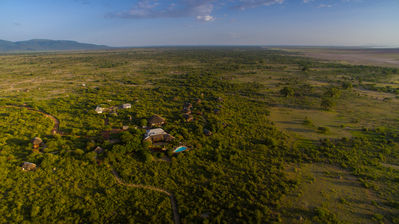
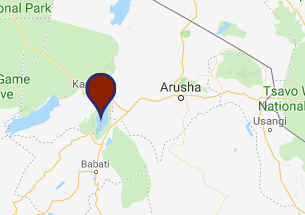
One outstanding feature of Tarangire is the huge number of enormous baobab trees. These giants, also known as upside down trees, are a strange and wonderful sight in themselves.
The Park is at its best in the dry season, when many of the migratory wildlife species come back to the permanent waters of Tarangire River. Huge herds of wildebeest, zebras, elephant, eland and Oryx gather in Tarangire until the start of the rains when they migrate again to good grazing areas.
There is a fine variety of game to be seen here, and the year round availability of water also attracts a great number of bird species. The park is relatively small at 2,600 square kilometres but is only a part of a much larger game conservation area. The scenery is beautiful with rolling countryside and a lovely river valley.
Access to Tarangire is good with the park being a two to three hour drive from Arusha, and it makes an ideal first or last stop on any safari.
Many safaris by-pass Tarangire on the way to the better known attraction further North, but the excellent quality of game viewing and the rewards of the scenery here mean that a stop, particularly in the dry season, is really worthwhile.
Aside from Tarangire Sopa Lodge, located inside of the park, there a number of luxury camps in the park and a variety of properties outside of the park offering bush walks and night game drives.


This comparatively small park, covering only 137 square kilometres, is little known and often by-passed, since visitors on a limited itinerary understandably want to see the more famous attractions. However, for those whose schedules and logistics permit, a visit to this park has much to offer and is a delightful introduction to the Parks and wildlife of Tanzania.
It is situated a short distance from Arusha itself, making it easy to visit on a day or half day trip. It is particularly suitable for those just arrived from Europe or the U.S. wanting not too taxing a first day, while they acclimatise and recover from their journey.
The park has several completely different habitats within its confines, from a flamingo fringed soda lake to dense forest, a crater floor almost like a miniature Ngorongoro and includes the foothills of Mount Meru, which at 4566 metres offers the 9th highest peak in Africa.
You will not see the enormous herds or predators of the plains here, but there are numerous monkeys, birds, giraffe, buffalo, hippo, warthogs, gazelle, and zebra, and even elephant may be spotted here.
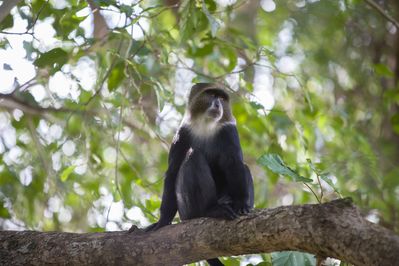

At 5,895 metres above sea level, Mount Kilimanjaro is Africa’s highest mountain. That it is a stand alone mountain and not part of a range, gives Kilimanjaro a prominent place on the horizon. The snow caps are iconic and have lent inspiration to the likes of Hemingway and more. The most common images of Kili are from Amboseli National Park in Kenya. Bordering on the mountain, it dominates the view and serves as backdrop for stunning photographs.
Aside from the beauty of the mountain, its biggest allure is the opportunity to try reaching the summit – Uhuru Peak. Each year, we help thousands reach the top of Mount Kilimanjaro via one of five routes. We prepare them for the challenge and give them expert guidance along the way. We offer different standards of service during the climb, depending on your budget.
Visit our section on Kilimanjaro Climbs for more information.
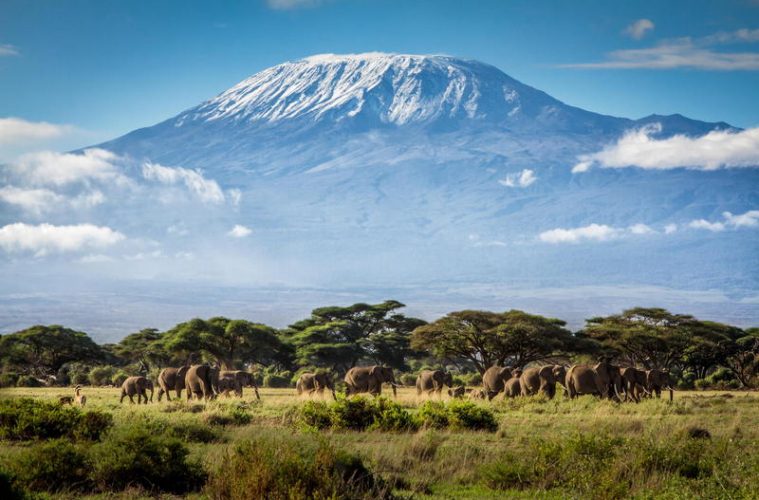
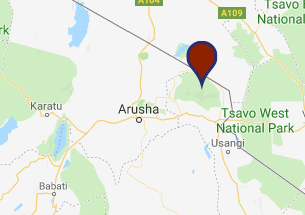
The reserve is named after the late Captain Frederick Courteney Selous, a famous elephant hunter who was killed by a German sniper in 1917.
General accessibility to the 55,000 sq km reserve used to be difficult, however, there are now a number of scheduled flights from Dar es Salaam and a convenient dirt road linking the park with other southern Tanzanian attractions. The reserve is immense, remote and wild and no human habitation is allowed within its boundaries, apart from within camps and lodges.
Today it boasts some of Africa’s finest virgin bush, unchanged through centuries and inhabited by three quarters of a million wild animals. The river systems and gorges are fascinating, as are the swamps, woodlands and savannahs, all home to hippo, crocodile, elephant, buffalo, wildebeest, zebras, giraffe, waterbuck, baboon, leopards, lion, wild dog, eland, sable and roan, to mention just a few of the species.
The bird-life is also extremely rich. There are a number of camps in the northern sector of the park, offering a mix of rustic and exotic accommodation. Game drives are by open four-wheel drive vehicle or by boat, a wonderfully peaceful way to view game. For a real highlight, choose a safari that offers escorted walking safaris.
At 10,300 square kilometres, Ruaha National Park is Tanzania’s second largest. Located in the southern half of the country, the park is not as frequently visited as those located in the north making it the perfect location for people wanting to be off the beaten path. The herbivores of this park, including Grant’s gazelle, lesser and greater kudu, roan antelope, impala and waterbuck face a daily challenge of evading a range of predators including several prides of lions and other cats such as leopards and cheetah. They also face a threat from both the spotted and striped hyena as well as packs of the endangered wild dog.
Walking safaris are offered in Ruaha giving an exceptional opportunity to experience this true wilderness area on a one to one basis with nature. These are provided only at a few camps at an additional cost paid directly to the camp. Naturally, vehicle based game viewing is also possible and the park features an extensive game trail network.
If you are looking for elephants, Ruaha National Park is the place to be. With more than 10,000 elephants, the park has the largest population of any in East Africa.
Mikumi National Park is an ideal location if you are short on time but long on an adventure. Its accessibility also makes it an attractive destination for any start to the southern safari circuit.
After an early morning wake up call and hot coffee or tea, one departs in 4×4 safari vehicle scouting for wild life. The early morning animal movements are a sight worth seeing with antelope, buffalo and elephants parading to the watering holes before embarking on a day’s worth of grazing. Return back to the lodge for a well-deserved rest and afternoon siesta. Depart of a mid-afternoon game drive. Guests often prefer to stay at the lodge and enjoy the tranquillity of their surroundings.
A number of indigenous southern mammal species exist at Mikumi including elephants, lions, zebra, wildebeest, impala, and giraffe and buffalo herds. Mikumi boasts of 400 species of local bird species including a variety of European migrants during the rainy season.
Udzungwa Mountains National Park
The Udzungwa Mountains National Park is perhaps one of the least known treasures of Tanzania. Within this park’s 1,990 square kilometres is a hiker’s paradise. A four hour hike in the bush and hills is rewarded with a spectacular view of the Sanje Waterfall cascading 170 metres to forested valley below.
The closed canopy forest provides a tranquil environment with the sounds from the hundreds of bird species, some only found in this area, creating a symphony of nature. The park is home to six primate species including the red Colobus monkey and Sanje crested mangabey which has only been spotted in this park.
Saadani National Park
Saadani National Park is set on the coast of Tanzania north of Dar es Salaam. Here you can experience untamed, untouched East Africa combined with the beauty of the Indian Ocean.
A visit here offers several aspects of Tanzania in a concentrated area. The sandy beach is home to fishermen reeling in their daily catch and near to the Wami River and a lagoon abundant with turtles. You can visit a local village after breakfast, have a game drive before lunch and spend the afternoon relaxing on the beach, watching the warm Indian Ocean waves lap the sparkling sand.
The park is accessed by scheduled and charter flights and can be accessed from Dar es Salaam by road with a four hour drive.
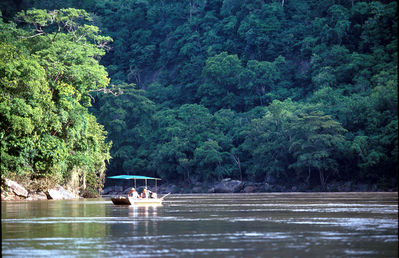
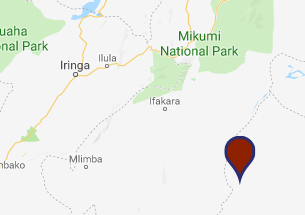
Gombe Stream National Park
Tucked away on Tanzania’s western border at Lake Tanganyika is Gombe Stream National Park. The park was made famous by Jane Goodall’s research into the chimpanzees found there. At only 52 square kilometres, Gombe is Tanzania’s smallest National Park.
The main attraction here are the chimpanzees. Visitors can arrange daily tracking sessions and spend time observing these amazing primates that are thought to have evolved along a similar path to man. Birders will enjoy a visit to this park as well. There are more than 200 species that have been recorded including the fish eagle and Peter’s twin spot.
The park is reached by boat from Kigoma. Kigoma can be reached by scheduled flights from Dar es Salaam and twice weekly flights from the Northern Circuit and Arusha. Visitors should plan on staying at least two days for a better probability of seeing the chimps. There is a luxury tented camp in the park.
Mahale Mountains National Park
Accessible only by twice weekly or private charter air service from Arusha, Dar es Salaam and certain parks, Mahale Mountains National Park is one of Africa’s most exclusive areas. The park itself measures 1,613 square kilometres and has an extensive shoreline along Lake Tanganyika.
The most popular activity in the park is tracking chimpanzee. Most visitors plan at least two days* for this activity to be sure that they are able to spend some time observing these amazing primates. Other activities include nature hikes, snorkelling, and fishing.
*Scheduled flights operate on Mondays and Thursdays meaning that stays are generally 3 or 4 nights. If travelling from Dar es Salaam, at least one night in Ruaha National Park is required before the flight as the scheduled flight originates from Ruaha early in the morning. The return flights terminate in Dar es Salaam with the chance of connecting to Zanzibar.
Katavi National Park
Katavi National Park is located on the western side of Tanzania between lakes Tanganyika and Rukwa. Within the park’s 4,471 kilometre area you can find the full range of wildlife including the elusive sable and roan antelopes. The park also features Tanzania’s densest concentrations of hippopotami and crocodiles.
Some 4,000 elephants roam the park and varieties of antelope spend their days trying to avoid becoming a meal for the many lions and spotted hyena. The best game viewing in season is along the Katuma River. One of the most fascinating events that can be seen in Katavi is the territorial struggle of the hippos when the water supply in the pools is low.
Along with walking and vehicle based wildlife viewing, many visitors visit the tamarind tree thought to be inhabited by the spirit of Kitabi. This celebrated hunter is still honoured by the local tribesmen who leave offerings at the tree in hope of his blessing. The park is accessible by scheduled and charter flights and there are luxury tented camps available for accommodation.
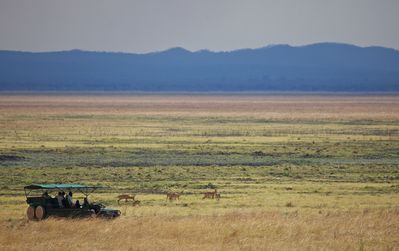
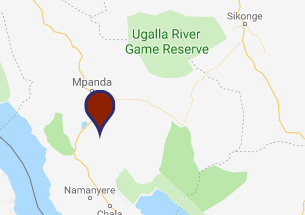
Zanzibar
The archipelago of Zanzibar is a collection of two main islands and several smaller islands. Unguja Island is the most popular and many think this island alone is Zanzibar. It has earned the nickname of “The Spice Island” because of the long history of growing and trading in spices that dates back for centuries. The island’s most populous city is also called Zanzibar, but often referred to as “Stone Town” because of the many buildings built from coral stone.
Visitors to this island have a vast variety of activities and accommodation choices. Stone Town is rich with history and culture. Once a major Arab trading port with records of settlement as early as the 11th century, Muslem traditions are well intertwined with the Swahili culture. Zanzibar was also an important port in the slave trade from the 17th century until 1897. Visitors can see a memorial to the slave trade near the Anglican Cathedral that was built on the site of the slave market. You can also explore the area where the slaves were kept prior to the auctions. Further up the coast from the city are the Mangapwani Slave Caves where they were hidden.
Other popular places to visit in the city are the Arab Old Fort, the House of Wonders, the museum, and the city market. The Anglican Cathedral should not be missed. The wonderful stained glass windows are complemented by a series of copper plates depicting the story of Christ. However, the Moslem culture dominates the city and throughout the day the call to prayer can be heard from the towns many minarets.
Accommodation in Zanzibar’s Stone Town vary widely in quality and price.
For holidaymakers interested in the beach, Zanzibar has miles of spectacular beaches along the north, east and south coasts. Accommodation choices range between five star resorts to small guest houses.
There are also exclusive villas. Most properties feature access to PADI SCUBA diving and also offer snorkelling. The coral reefs are an attraction to swimmers.
Each of the many choices of accommodation have their unique offer of activities. Some have tennis, discothèques, animation, live music, cultural theme meals, sailing excursions and fishing. All offer a great place to relax in the sun.
Other activities of interest include tours of the spice gardens, visits to historic ruins, a guided tour of the historic Stone Town, a boat trip to Prison Island, or a dolphin safari. Jozani Forest can also be toured and features mangrove forest as well as the extraordinary red Colobus monkey.
There are smaller islands that dot the coastline of Unguja. These include Mnemba, Chumbe, and Chapwani Islands. Each of these islands features a unique and exclusive accommodation offering.
There are several flights daily to Zanzibar from the Northern Circuit connecting through Arusha and the Southern Circuit connecting through Dar es Salaam. Several Airways offers flights from Nairobi and Mombasa. There are also a number of ferries that travel to Zanzibar from Dar es Salaam.
Pemba
Pemba is located to the north of Unguja. The island is less frequented by tourists and there are only a few resorts that we would recommend. All offer exceptional diving and snorkelling. The island is home to a bird sanctuary and is a hidden treasure for birding enthusiasts. There are daily flights to Pemba from Arusha, Dar es Salaam and Zanzibar.
Mafia Island
Though not part of the Zanzibar archipelago, Mafia Island is also a popular destination for diving and snorkelling enthusiasts. Deep sea fishing can also be arranged for guests staying on the island. The island lies 160 kilometres south of Zanzibar and can be reached by scheduled and chartered air service from Dar es Salaam. There are a number of recommended places to stay on the island that offer a variety of water sports activities.
Thanda Island
Located a few kilometres north of Mafia Island, this small island can be hired for exclusive use. It features a private villa with 5 connected guest suites in a central building. Access is only by boat from Mafia Island or by private charter helicopter from Dar es Salaam.
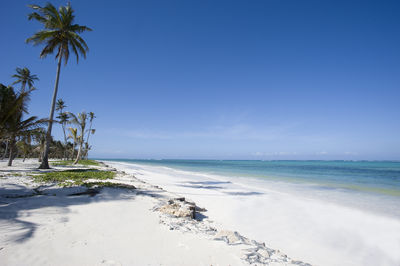

We have a number of scheduled safaris departing on a weekly basis throughout the year. Click on the link to find out more.
Find out more
To keep in touch with news from the Ranger Safari's team and to receive our e-newsletter, please leave your e-mail address below.